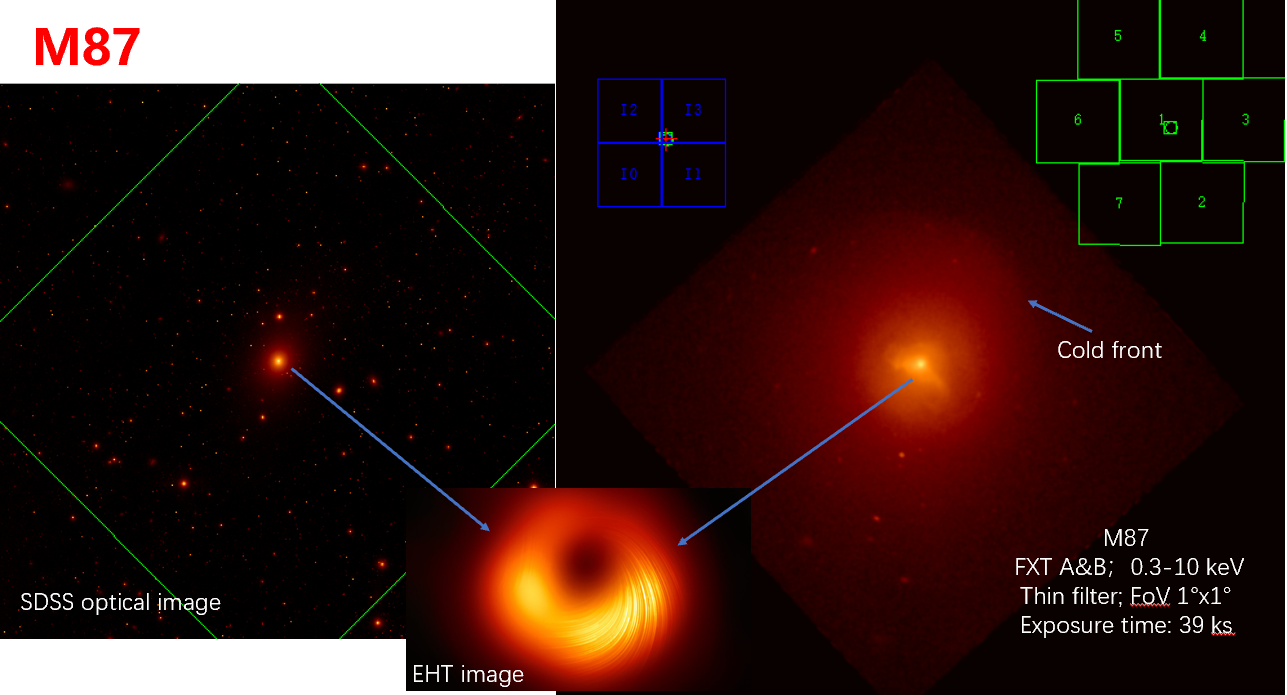EP Captures Its Debut In-orbit Images
The 7th Joint Workshop of the Einstein Probe Consortium was held in Beijing from 24 to 26 April 2024. During the workshop, status and performance of the Einstein Probe (EP) satellite and its payloads were reviewed. Plans for future observations and research were discussed. Following the workshop, the EP mission released its first set of images acquired in orbit.
Since its launch on 9 January, 2024, commissioning tests have been conducted, which confirmed the functionality and performances of the EP satellite and its payloads. During the commission phase, EP captured X-ray images from various celestial bodies. These observations have demonstrated the outstanding capabilities of EP's two scientific instruments, the Wide-field X-ray Telescope (WXT) to make panoramic scans of the X-ray sky and the Follow-up X-ray Telescope (FXT) to provide a close-up view and pinpoints the transient sources captured by WXT.
“The results have fully verified its unique large field of view, high sensitivity, and fast time-domain surveying and monitoring capabilities,” says Weimin Yuan, principal investigator of the EP mission and a researcher at the National Astronomical Observatories of the Chinese Academy of Sciences (CAS). “With great efforts, our team made the mission impossible possible,” he adds.

Figure 1: Image captured by WXT directed at the center of the Milky Way galaxy for around 40,000 seconds. WXT’s lobster-eye optics highlights almost all bright X-ray sources, with cruciform-shaped spots identified in purple, and the blue cloud-like structures portraying the emission of foreground hot gas surrounding the galaxy. WXT has the largest X-ray focusing field-of-view (FOV), capable of imaging nearly 1/11th of the entire sky in an instant. Image credit: EPSC, NAO/CAS; DSS; ESO
(WXT's X-ray sources are identified in purple, overlaid with the DSS color image provided by ESO. X-ray data credit goes to the EPSC, while ESO credits the DSS data.)
Up to now, WXT has already completed the instrument calibration for 10 of its 12 modules. “The calibration results showed that the WXT meets the EP’s scientific requirements with a positioning accuracy of about 2 arcmin, an angular resolution of 4 to 5 arcmin, and a light collecting area of approximately 3 cm2@1 keV,” explains Chen Zhang, assistant to EP's principal investigator, “WXT has the potential to revolutionize X-ray sky surveys and usher in a new era of cosmic discovery.”
In-orbit tests also verified the accuracy of the light-collecting capability, spatial resolution, and source positioning capabilities of FXT, with a light collecting area of about 300 cm2 @1.25 keV and an angular resolution of around 23 arcsec for each of its two identical units. “Of particular note was the development of windowed and time-varying observing modes, which provides effective, bright source observing capability,” says Yong Chen, leader of the FXT team at the Institute of High Energy Physics.

Figure 2: M87 is a bright, giant elliptical galaxy situated within the Virgo galaxy cluster. In contrast to optical images, FXT detected a significant amount of dispersed hot gas within M87 during its X-ray observations. Within the central region, two arm structures were observed, generated by the jets originating from the massive black hole. These jets expel the cold gas originally located in the central region. Furthermore, FXT also identified a cold front located around the outer periphery of M87, characterized by significant variations in brightness.
Up to now, FXT has effectively performed multiple follow-up observations in-orbit on several transient sources discovered by WXT, pinning the source positions down to less than 10 arcsec and demonstrating its superior positional capabilities and exceptional sensitivity.
“It is astounding that even though the instruments were not yet fully calibrated, we could already perform a time-crucial follow-up observation using the FXT instrument of a fast X-ray transient first spotted by the WXT instrument,” explains Dr. Erik Kuulkers, ESA’s Einstein Probe Project Scientist. “It shows what Einstein Probe will be capable of this during its survey.”
“Einstein probe leverages the instrument developments we made for eROSITA to open up new scientific opportunities,” says Paul Nandra, Director of the MPE high energy group. “The collaboration has worked perfectly – we’re looking forward to the next one!” He adds.
During the commissioning phase to date, EP has detected 17 X-ray transients and 168 stellar flares, which were reported in over 20 global telegrams released. These findings guided a range of ground- and space-based telescopes to carry out crucial follow-up observations in multi-wavebands, including optical facilities like Keck and VLT, radio telescopes like VLA, and X-ray telescopes like Chandra.
Preliminary analysis of the data from EP and other telescopes confirmed EP's potential to discover diverse X-ray sources and even new types of objects, and its important role in unveiling the evolution of the Universe and the structure of spacetime.
Over the coming months, EP will continue carrying out its in-orbit calibration activities before entering the operational phase starting around mid-June of 2024.
Einstein Probe is one of the serial space science missions of the Strategic Priority Program on Space Science (Phase II) led by CAS. It is also an international collaboration mission with contributions from the European Space Agency (ESA), the Max Planck Institute for Extraterrestrial Physics (MPE) in Germany and the French space agency, Centre National D'Etudes Spatiales (CNES). EP is supported by ESA as an opportunity mission